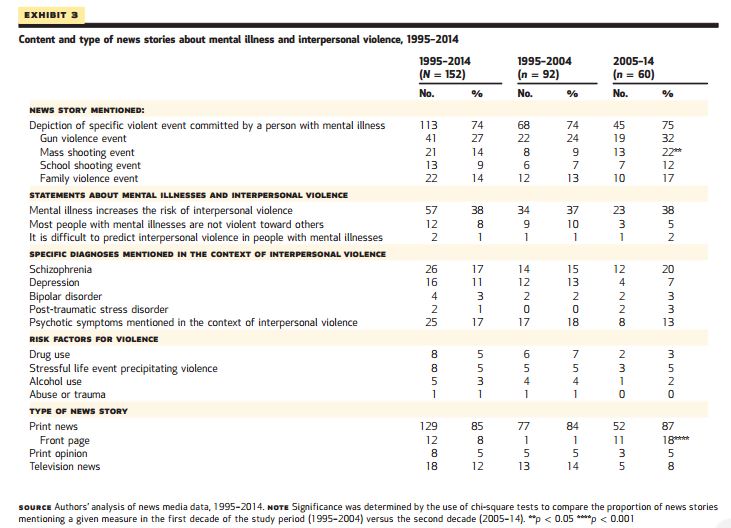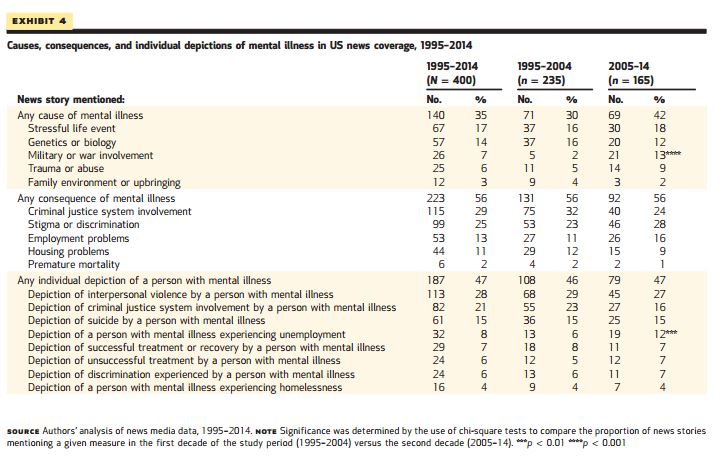The news media frequently write stories that connect mental health issues with violence, according to a new study published this month in Health Affairs. After analyzing a sample of 400 news stories about ‘mental illness’ written between 1995 and 2014, researchers found that the increasing emphasis on violence and mass shootings were “highly disproportionate to actual rates of violence” among those with mental health issues. This gap between what gets represented in the news and what occurs, in reality, may fuel stigma and decrease support for recovery-oriented mental health treatments and policies.
“Emphasis on interpersonal violence in news coverage of ‘mental illness’ is concerning given that most people with ‘mental illnesses’ are never violent, and only about 4 percent of interpersonal violence in the United States is attributable to ‘mental illness,'” the researchers write.
“News coverage linking interpersonal violence to ‘mental illness’ has been shown to exacerbate already high levels of social stigma toward those with ‘mental illnesses.’ This emphasis on violence instead of other ‘mental illness’–related topics might contribute to a societal focus on enacting public safety–oriented policies, such as mandatory treatment and firearm restrictions, at the expense of public health–oriented policies designed to foster recovery.”
There has been an increase in awareness and discussion of mental health issues in the United States over the last few decades. Unfortunately, much of that debate has been generated following high-profile acts of violence and mass shootings. Other narratives are often similarly negative, with many stories talking about mental health in connection with rising suicide rates, PTSD in military personnel, and high levels of untreated mental health issues in the US prison system.
One way of taking a closer look at the trends in a national discussion is through an assessment of coverage in the major news media with the understanding that the news often functions to simultaneously reflect and shape the views of the public. One way the news media can actively shape public discourse in through what is referred to as “issue framing.” Many media critics often focus on the ability of the news to cover some stories and ignore others (known as agenda-setting), but the way the media highlight certain aspects of an issue once it is covered can also affect public opinion and suggest particular types of policy solutions.
While previous research has documented a connection between news coverage of mental health issues, an interpersonal violence frame, and social stigma, including studies of the news in Canada, the UK, New Zealand, and Spain, no prior US studies have looked at news coverage of mental health issues over time. To fill in this gap in the research, the study authors examined a random sample of 400 US news stories about mental health in major print and television news sources from 1995-2014.
After coding all of the news stories, the researchers found that the most frequent depiction of a person with a mental health issue was of somebody committing a violent act. This depiction accounted for 28% of all depictions while only 7% of news stories included a person who had successful treatment or recovery.
Over the entire twenty-year period of the study, almost a quarter of all of the news stories studied mentioned a particular public policy issue. Of these, 19% included policies to support community services, 7% called for an expansion of inpatient treatment facilities, and 9% supported mandatory treatment policies. Stories that mentioned violent acts in connection with mental health issues were significantly more likely than others to include policy suggestions, potentially signaling that a majority of policy discussions of mental health occur within the context of fear and concerns about safety.

The researchers noticed an overall decline in the number of articles covering mental health issues over the period. They attributed this decline to the downsizing of newspapers that has disproportionately reduced the amount of science reporting. The way mental health problems are covered has not shown a significant change in twenty years, however. More than half of all news stories continue to mention some type of violence in connection with mental health issues.
“Overall, the most frequently mentioned topics pertained to interpersonal violence, suicide, and treatment of mental illness. Policies to improve or expand treatment were also the most frequently mentioned category of mental health policies, although such policies were mentioned in only 14 percent of stories. Criminal justice involvement was the most frequently mentioned consequence of mental illness, and when the news media portrayed a specific individual with mental illness, that individual was most frequently depicted as having committed an act of interpersonal violence.”

The emphasis on violence in news coverage is out of step with actual mental health research. Suicide appears to be much more directly related to mental health issues than violence, for example, yet news stories are much more likely to mention violence than suicide. The high percentage of coverage including violence is completely out of step with research on violence and mental health issues as well. The researchers suggest that this may result from policy makers arguing for mental helath policy changes after mass shootings “in an attempt to shift public attention and political momentum away from strengthening US gun laws,” even if the research shows that mental health treatment “will not meaningfully address gun violence in America.”
“Coverage has continued to emphasize interpersonal violence in a way that is highly disproportionate to actual rates of such violence among the US population with mental illness,” the researchers conclude.
“Initiatives to educate reporters and the opinion leaders they use as sources regarding the relationship between mental illness and interpersonal violence are needed, as are efforts to increase news media depictions of successful treatment for and recovery from mental illness, which have the potential to reduce harmful social stigma toward this population.”
****
McGinty, E.E., Kennedy-Hendricks, A., Choksy, S. and Barry, C.L., 2016. Trends In News Media Coverage Of Mental Illness In The United States: 1995–2014. Health Affairs, 35(6), pp.1121-1129. (Abstract)
















Will someone please do a study of violence rates among people with diabetes, gall bladder, prostate enlargement, etc.? (This would be in synch with Bob Whitaker’s approach of holding psychiatrists and others accountable for their actions based on their own logic, also in pursuit of an “evidence base” which may indicate whether there are other “disabled” groups which should be subject to similar preventive measures as the “mentally” disabled.)
Report comment
I agree 100%. Even saying that “only 4% of violence is attributable to mental illness” is still likely a distortion. What if 4% of any health-based sample engaged in violent acts? This seems like a reasonable number, considering the frequency of violence in the USA. Would anyone ever report that “only 4% of violence is attributable to high blood pressure” or “only 4% of violence is attributable to rheumatoid arthritis?” There is an automatic assumption that any violence committed by a person with some “mental health” label is “attributable” to their “mental illness.” Wouldn’t it make more sense to suggest that violence has many causes and occurs in all cohorts, which is clearly the factual truth?
Very aggravating!
—- Steve
Report comment
Exactly.
In inner city areas in the UK, like the catchment area of the Maudsley Hospital (practically) everybody has a history of violence.
Report comment
Let’s assume everyone who commits a mass murder is by definition, mentally ill. Then all we need to do is identify who “the mentally ill” are before they commit a mass murder and put them on a list or database. These people will not be able to buy guns or any other device used in mass murder. Beginning at age 16, everyone should be forced to take an MMPI once a year to see if they are safe. Those who fail can be locked away to protect the public. Then mass murder will stop. The psychiTrist and his DSM5 will protect us.
Report comment
Do you do standup?
Report comment
Precrime was done in “Minority Report” . Everybody runs! What are you running for?
Report comment
Can we use this idea on politicians, too?
Report comment
This is what I call reality manipulation (and what those in power call ‘perception management’).
Even though the evidence and reality says one thing (in this case, that most people diagnosed with a ‘mental illness’ are more likely to be victims of violence and not the perpetrators of violence) the mainstream media says almost the complete opposite, and because most people get their news/information from the mainstream media the majority of people (having their realities manipulated) believe what the media tells them and believe that ‘mentally ill’ people are violent. This of course benefits those in power as it allows them to then shape policy (after shaping the narrative) to expand the status quo of power, profit, and control. By framing ‘mentally ill’ people as violent it allows those in power to push legislation that removes the rights and freedoms from the ‘mentally ill’ and to forcibly detain, restrain, and medicate or electroshock a person against their will if need be because they are (claimed to be) violent.
Reality manipulation is also evident regarding other aspects of (biological) psychiatry, including the general public belief/understanding of what is/causes mental illness, such as the chemical imbalance theory. Even though there never is or was any evidence to support the chemical imbalance theory it is widely promoted by the pharmaceutical industry and through the mainstream media, so many/most laymen have the (false) belief that mental illness is caused by a chemical imbalance, even though the reality is that the chemical imbalance theory was never proven and has actually been actively disproven.
This reality manipulation is evident in other claims made by psychiatry and the mainstream media, such as the suggestion that ‘mental illness’ is a real biological illness, brain disease, or genetic defect, even though studies have repeatedly failed to prove any such claims, yet the majority of people believe these things to be truthful because the media constantly makes and repeats such claims (tell a lie long enough and loud enough and people will eventually believe it). Then there is the reality manipulation regarding suggestions that psychiatric drugs are ‘safe and effective’ even though there is much evidence, and even black box warnings, that say most psychiatric drugs are little more effective than a placebo yet come with a wide array of adverse effects, including violence (caused by the drugs, not the ‘mental illness’) and homicidal and suicidal ideation.
Reality manipulation is the norm, not the exception (think also propaganda and public relations). The television (and mainstream media) is a form of mass mind control. Most people in the Western world have atleast one television in their homes, and most people watch hours of television every single day. In American 90% of mainstream media sources are owned by just 6 corporations that control everything that people see, hear, and read. This corporate control of information shapes the views and beliefs of the people, which manipulates and controls the reality of the masses.
Report comment
Whenever anyone — even Bernie Sanders — makes a statement regarding guns or anything else and mentions “mental illness” in association with violence they should be asked to provide the statistics to back up their claims and held to it. And if it turns out that cigarette smokers or colon cancer patients have an even higher proclivity to violence we should demand they too have their guns confiscated, and that they be profiled and monitored. Can’t be too careful.
Report comment
If they pass legislation to keep guns out of “the wrong hands”, and if “mentally ill people” are those who have “the wrong hands” then politicians, police, judges have 374 new ways to take away guns. This will also create a direct pipeline between psychologists, psychiatrists and a police data bank. Thus on any given day, as each person exits a visit to his therapist, his medical record is being shared with and published by a police data bank. Once listed, you are listed forever with zero chance of being delisted. I see a problem with this.
Report comment
If you check Obama’s big recent “gun control” speech, that’s what they’re already de facto implementing, especially with Social Security “disability” lists. Not only psychotherapists — as many people will attest who have recently visited their physicians for specific physical issues only to be asked about their “feelings,” and whether by the way they have a gun in the house.
Report comment